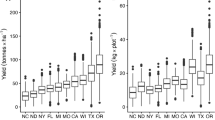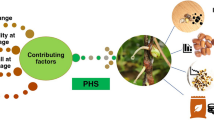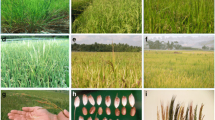Summary
The winter wheat variety Atlas 66 has both the characteristics high protein content in the kernel and tolerance to high soil acidity. In a group of 121 F4 lines, all derived from crosses with Atlas 66, a correlation coefficient of 0.39 was found between the two traits. A comparable group of 49 advanced generation lines, reselected for high protein content behaved similar, with a correlation coefficient of 0.37.
The frequency distribution over the different categories of tolerance to soil acidity was tested within F3 and F4 populations of each two crosses between an Atlas 66-derived high-protein selection and a HRWW-variety. Both crosses slightly differed in frequency distribution but there were no differences between F3 and F4 distribution curves of one cross combination.
Samples of varieties were tested, each sample having a phenotypically different protein content. The results indicated that protein content per se did not influence the level of tolerance to soil acidity. So it is concluded that although the two characteristics are genetically different they are linked to a certain extent.
Individual regression lines were calculated for separate groups of F4 selections derived from one cross combination. Two groups deviated from the majority and general pattern in that they showed a negative correlation between high protein and better tolerance. One of them differed significantly. A hypothesis is suggested to explain these exceptions.
It is possible to screen lines for tolerance to high soil acidity in order to select within segregating populations for high protein content in the kernel, provided that positive selection is applied and that one of the parents combines both characteristics.
Similar content being viewed by others
References
Foy, C. D., Armiger, W. H., Briggle, L. W. &Reid, D. A., 1965. Differential aluminum tolerance of wheat and barley varieties in acid soils. Agron. J. 57: 413–417.
Haunold, A., Johnson, V. A. &Schmidt, J. W, 1962a. Variation in protein content of the grain in four varieties ofTriticum aestivum L. Agron. J. 54: 121–125.
Haunold, A., Johnson, V. A. &Schmidt, J. W., 1962b. Genetic measurements of protein in the grain ofTriticum aestivum L. Agron. J. 54: 203–206.
Johnson, V. A., Schmidt, J. W., Mattern, P. J. &Haunold, A., 1963. Agronomic and quality characteristics of high protein F2-derived families from a Soft Red Winter-Hard Red Winter Wheat cross. Crop Sci. 3: 7–10.
Kerridge, P. C. &Kronstad, F. W., 1968. Evidence of genetic resistance to aluminum toxicity in wheat (T. aestivum Vill.,Host) Agron. J. 60: 710–711.
Mesdag, J. &Slootmaker, L. A. J., 1969. Classifying wheat varieties for tolerance to high soil acidity. Euphytica 18: 36–42.
Middleton, G. K., Bode, C. E. &Bayles, B. B., 1954. A comparison of the queantity and quality of protein in certain verieties of soft wheat. Agron. J. 46: 500–502.
Author information
Authors and Affiliations
Rights and permissions
About this article
Cite this article
Mesdag, J., Slootmaker, L.A.J. & Post, J. Linkage between tolerance to high soil acidity and genetically high protein content in the kernel of wheat,Triticum aestivum L. and its possible use in breeding. Euphytica 19, 163–174 (1970). https://doi.org/10.1007/BF01902940
Received:
Issue Date:
DOI: https://doi.org/10.1007/BF01902940




